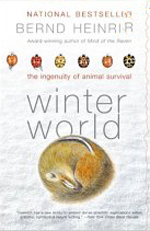Review of "Winter World: The Ingenuity of Animal Survival"

Author(s): Bernd Heinrich
Published: January 7, 2003, HarperCollins Publishers, Inc, ISBN: 0060197447
 by James A. Huggins, Ph.D., University Professor & Director of the Hammons Center for Scientific Studies
by James A. Huggins, Ph.D., University Professor & Director of the Hammons Center for Scientific Studies
January 18, 2008 -
Winter World is a book that every aspiring ecologist should read for the sheer wonder that it portrays within God’s created array of life. God’s clever and varied approaches to solving survival problems for creatures that must live and reproduce in a fallen and frigid world is indeed a testimony to His omniscience. I only wish that author Bernd Heinrich saw more of our Creator in the Creation to which he has devoted much of his private and professional life. As is true for many hardships that now face our world, kinetic expenditures must not exceed kinetic receipt. Such an imbalance during winter quickly represents a death sentence to those creatures that are ill-equipped to match energy production with energy need during this season of frequent deprivation. The abilities and approaches that allow animal and plant life to survive environmental temperatures that test the limit and ability of the economy of energy kinetics are perhaps innumerable but the author addresses many of the better understood mechanisms. Heinrich does a masterful job of explaining for the layman the many concepts that surround adaptation to the cold. He addresses everything from cellular machinery to molecular antifreeze and super-cooled liquids to the significance of Bergmann’s Rule and the insulating capacity of snow.
Heinrich’s references to various species of kinglets and the weasels were perhaps my favorite illustrations. He is at once capable of building within the reader a profound admiration for the creature and the environmental niche into which it must so precisely fit. I could in my mind’s eye see the ruby-crowned kinglet on a frozen branch, hear the gentle rush of the north wind and feel the touch of falling snow and the ice under its feet; literally transported to the winter world of the bird that sought so desperately to find food before nightfall. It is indeed rare when a science writer is able to teach biological facts while mesmerizing his audience with the landscape and the predicament of the creature. He is a naturalist and a writer of the first order as well as one that truly loves his work. I appreciated his ability to quickly spot the significant and dismiss the miniscule without overlooking underlying possibilities, e.g. flight feathers as potential rain guards. I do not believe for one minute, since scripture tells us that birds flew before rain fell, that fight feathers evolved as rain guards but I certainly accept the fact they serve that purpose well in given situations. Much of what he wrote about I already knew from my many years of sharing his love for God’s creation (my emphasis not his) but more than once I found his insight into certain unknown or scientific gray areas to be particularly enlightening, if not for the science itself then for how the mind of an evolutionist might work in providing explanation for a world that is perceived to have come from itself.
The reader will learn why ermines are solid white in winter except for the dark tip of a tail, they will learn of torpor, hibernation, insulation, fat versus carbohydrate metabolism, of multispecies flocks, of winter roost sites, huddling for warmth, food caching, migration, double clutching, the inter-relationships of berries and birds, of the bear who thought a beagle her cub and how John Colter in 1809 once escaped a pursuing band of Blackfeet by capitalizing on his knowledge of the natural world. These are valuable bits of information for anyone with the heart of a naturalist. Once again, Winter World is a great read that is filled with nature adventure, discovery and a testimony to God’s ingenuity. I highly recommend it.

